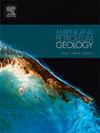Enhanced strategies for depressurization in offshore natural gas hydrate exploitation: An in-depth investigation into pathway optimization and production stability mechanisms
IF 3.7
2区 地球科学
Q1 GEOSCIENCES, MULTIDISCIPLINARY
引用次数: 0
Abstract
Natural gas hydrates have garnered widespread attention as a high-quality energy resource. Recent offshore extraction experiences suggest that depressurization is a technically mature and economically viable option. However, challenges such as reservoir temperature reduction, reservoir subsidence, secondary hydrate formation, and insufficient dynamics in later-stage hydrate decomposition still require improvements to the depressurization method. This study, based on field data from Japan's first offshore natural gas hydrate extraction, utilizes a self-developed numerical simulator to model and validate reservoirs at the field scale. Long-term production rate stability, total production, secondary hydrate formation, reservoir subsidence, evolution of permeability, and temperature-pressure paths were analyzed and optimized for the three mainstream depressurization modes: steady depressurization, stepwise depressurization, and cyclic depressurization. The results indicate that, under the condition of equal total work done throughout the entire depressurization process, steady depressurization with an effectively lower depressurization rate is the optimal choice. Cyclic depressurization, due to the formation of secondary hydrates reducing the permeability of certain reservoir zones, adversely affects gas production efficiency during the long-term stable production phase. This study enhances insights into the coupled evolution of multiple physical fields during the depressurization of offshore natural gas hydrates, providing valuable guidance for future on-site extraction plan designs.
海上天然气水合物开采中的减压强化战略:对路径优化和生产稳定性机制的深入研究
天然气水合物作为一种优质能源资源受到广泛关注。最近的海上开采经验表明,减压是一种技术上成熟、经济上可行的方案。然而,储层温度降低、储层沉降、二次水合物形成以及后期水合物分解动力不足等挑战仍然需要对减压方法进行改进。本研究以日本首次海上天然气水合物开采的现场数据为基础,利用自主开发的数值模拟器在现场规模上对储层进行建模和验证。针对三种主流减压模式:稳定减压、分步减压和循环减压,分析并优化了长期生产率稳定性、总产量、二次水合物形成、储层沉降、渗透率演变和温度压力路径。结果表明,在整个减压过程总功相等的条件下,稳定减压的最优选择是有效降低减压率。由于二次水合物的形成降低了某些储层的渗透率,循环减压会对长期稳定生产阶段的天然气生产效率产生不利影响。这项研究加深了对海上天然气水合物减压过程中多个物理场耦合演化的了解,为今后的现场开采方案设计提供了宝贵的指导。
本文章由计算机程序翻译,如有差异,请以英文原文为准。
求助全文
约1分钟内获得全文
求助全文
来源期刊

Marine and Petroleum Geology
地学-地球科学综合
CiteScore
8.80
自引率
14.30%
发文量
475
审稿时长
63 days
期刊介绍:
Marine and Petroleum Geology is the pre-eminent international forum for the exchange of multidisciplinary concepts, interpretations and techniques for all concerned with marine and petroleum geology in industry, government and academia. Rapid bimonthly publication allows early communications of papers or short communications to the geoscience community.
Marine and Petroleum Geology is essential reading for geologists, geophysicists and explorationists in industry, government and academia working in the following areas: marine geology; basin analysis and evaluation; organic geochemistry; reserve/resource estimation; seismic stratigraphy; thermal models of basic evolution; sedimentary geology; continental margins; geophysical interpretation; structural geology/tectonics; formation evaluation techniques; well logging.
 求助内容:
求助内容: 应助结果提醒方式:
应助结果提醒方式:


